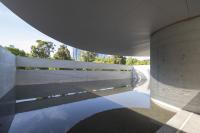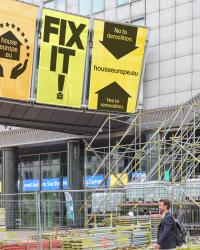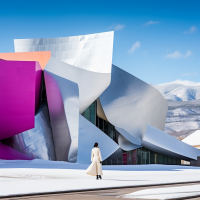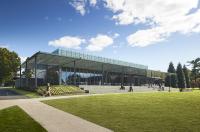Hangzhou Urban Design Sheme
Hangzhou, China
Hangzhou is awarded the right to host the 2022 Asian Games (XIX Asiad). The Asian Games Village site is located along the east coast of Hangzhou Qiantang River, close to the Qianjiang Century City CBD. The masterplan covers 2.96km2, which is 3km away from the Hangzhou Olympic Sports Center (Asian Games main stadium area).
The Athlete Village will accommodate all involved with the Asian Games; from performing athletes, to referees and media personnel. The future aim is to incorporate the village into Hangzhou’s Central Business District – and will do this by making place for businesses and trade. The forward-thinking village will accommodate 60,000 inhabitants, and will encourage a fully sustainable and environmentally-friendly standard of living for society.
The total land-area of planning is 3.26km2, of which 2.41km2 will be dedicated to the construction of the Asian Games Village. A controlled green-belt along the Zhegang Railway will comprise 0.55km2, and the Qiantang Riverside Park area will comprise 0.3km2.
The planning area is in close proximity to the main stadium for the Asian Games.
Requirement for Planning and Key Elements of Project:
-The planning shall strengthen the urban development of Qianjiang Century City, reflecting its strategic role in Hangzhou’s spatial ambition of “development embracing the river”, in terms of space, landscape, function and city image.
-To create a world-class Asian Games Village by utilizing ecological and intelligent planning approaches, and building a games village tailored to the athletes, and sports personnel.
-To anticipate future growth of the city by incorporating advanced planning concepts such as: dense grids, mixed-use districts, and city-industry integration and sustainable living.
Skyline
A T-shaped city skyline will silhouette the mixed-use high-rise buildings. It will run along the length of the Water-Park, and along the village’s outer edge – along the Qiantang River.
Ecology
Green-Parks will provide the village with pollution-free air and purification of water. This will merge the built-up urban areas with a rural atmosphere, and will promote sustainable city living. Ecological research should be supported through education and research (Educational Centre, Urban Farming, Purification systems).
Built Structure
Mixed-use buildings will create a dynamic environment and will encourage an organic society, which will oppose functional division. This is the key element of a liveable city. A new urban model inspired by the traditional urban city will make up the built planning area. An urban-cluster concept (120m x 120m) is optimal in relationship to the entire site.
Traffic
There will be a radical reduction of traffic in favour of pedestrians and the environment. Electric self-driving buses will be the main transportation system of the village. The majority of streets will be shared-space schemes, which will give priority to pedestrians. Large Scale: Monorail and subway connecting the Qiantang Riverbanks of the new centre. Medium Scale: Cable-car connecting the planning area and riverbanks. Small Scale: Self-driving buses, service vehicles, Park and Ride schemes, waterways.
Office Buildings
By opposing functional division within the city, these mixed-use buildings will be a multilayer system, merging various functions such as: commercial, retail, leisure and residential. Sky lobbies and outdoor green terraces will offer interaction and relaxation to the working and non-working community. Buildings will connect via a sky-bridge and will allow pedestrians to have an alternative network.
Housing
The aim is to restore identity and character within the residential units. By downscaling the housing block and creating individuality within the façade design, housing occupants will feel more comfortable to call it their home. Ground floor retail and common spaces will offer places for people to interact. Human-scale will be restored into high density residential clusters. Large green courtyards and green-roofs for ecology and growing food will provide an sustainable standard of living.
Functions and Land-use during the 2022 Asian Games (XIX Asiad)
Concentrating on the main facilities and services along the Water-Park and Green-Park. A new silhouette of the city zone will be erected in the first phase (Asian Games) creating character and identity for the whole area. Dominated elements of water, green parks and underground traffic are perfect boundaries for the temporary isolation because of the security reasons during the games. No demolition or complicated reconstruction would be necessary to enlarge the entire site area in long term development after the XIX Asiad. After the games, both parks can be easily transformed into the major recreational area for future citizens. Public transportation systems will use very compact linear routes, enabling the shortest possible transportation distances between the major activities.
Functions and Land-use after the 2022 Asian Games (XIX Asiad)
After the games, the entire planning area will accommodate approximately double the number of citizens. Therefore, the facilities, services and public transportation should be easily adopted for the future needs. New schools, kindergartens, hospitals and creative industry hubs could be easily implemented into the primary grid. The ecological park along the railway-line will be shared between the several housing areas in the neighbourhood.
- Architects
- Jadric Architektur
- Location
- Xiaoshan District, Hangzhou, China
- Year
- 2018
- Team
- Klaus Semsroth, Oliver Flew, Goran Papo, Maximilian Krankl, Jakob Mayer, Nikolaus Punzengruber











